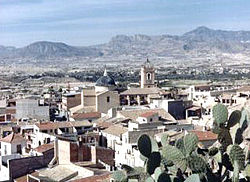Abanilla
38°12′N 1°03′W / 38.200°N 1.050°W
Abanilla | |
|---|---|
 | |
 | |
| Country | Spain |
| Province | Murcia |
| Comarca | Comarca Oriental |
| Government | |
| • Mayor | Ezequiel Alonso Gaona (PSOE) |
| Area | |
• Total | 236.6 km2 (91.4 sq mi) |
| Elevation | 201 m (659 ft) |
| Population (2008) | |
• Total | 6,642 |
| • Density | 26.48/km2 (68.6/sq mi) |
| Post code | 30640 (Abanilla Town), 30648 (Barinas) |
| Area code(s) | 968 and 868 |
| Website | www.abanilla.es |
Abanilla is a Spanish municipality located in the Comarca Oriental (composed by Fortuna and Abanilla) in the Autonomous Community of Murcia. It lies close to the border of the province of Alicante in the Autonomous Community of Valencia.
Geography
Abanilla occupies a surface area of 236.6 km² and is situated 222 metres above sea level. It lies on a natural foundation which has been degraded by a number of aggregate and marble quarries.
The remarkable Quibas paleontological site lies within the limits of the municipality.
Points of interest
Points of interest in Abanilla include the Old Town (containing the monument to the Corazón de Jesús), the Fuente de Algarrobo (Fountain of the Carob Tree), the Santuario de Mahoya (Sanctuary of Mahoya), and the Iglesia Parroquial de San José (Parochial Church of St. Joseph). Other sights worth visiting include the source of the River Chícamo and the mountains of Abanilla and Quibas.
Monuments
Buildings of monumental significance in Abanilla include the La Iglesia de San José (the Church of San José) (18th century), El Sagrado Corazón (Sacred Heart) in Abanilla Town and Barinas, La Casa de la Encomienda, La Casa Cabrera, La Casa Pintada, El Monumento a las Fiestas de Moros y Cristianos (the Monument to the Festivals of the Moors and Christians) and La casa del francés (the French's house).
There is a destroyed medieval enceinte in Abanilla.
Local communities

Local communities within the Abanilla municipality include the following.
- Barinas, a rural town located 11 km from Abanilla town, at an elevation of 379 m.
- Macisvenda, located 10 km from Abanilla town, a crossroads of the roads to La Algueña, El Cantón, Hondón de los Frailes and Hondón de las Nieves.
- Other communities include Mahoya, El Cantón, Cañada de la Leña, El Partidor, El Tollé, Los Baños de Fortuna, Casa Cabrera, Casa Pintada, Los Carrillos, La Umbría, Collado de los Gabrieles, Ricabacica, El Algarrobo, Campules, Balonga, Mafraque and El Olivar.

Politics
The mayor of Abanilla was Álvaro Gaona (Partido Independiente) from 1979 to 1983, José Luís Cutillas Rivera (Partido Socialista Obrero Español) from 1983 to 1987, Fernando Molina Parra (Partido Popular) from 1987 to 2015 and Ezequiel Alonso Gaona (Partido Socialista Obrero Español) from 2015.
Demographics

The population of Abanilla is 6,256 (INE, 2005), with a population density of 26.48 persons/km².
| Demographic evolution in Abanilla 1857-2008 | ||||||||||||
|---|---|---|---|---|---|---|---|---|---|---|---|---|
| 1857 | 1860 | 1877 | 1887 | 1897 | 1900 | 1910 | 1920 | 1930 | 1940 | 1950 | 1960 | |
| 4.324 | 4.650 | 5.689 | 5.617 | 6.121 | 6.634 | 7.451 | 7.641 | 8.179 | 8.220 | 8.620 | 8.594 | |
| 1970 | 1981 | 1991 | 1996 | 2001 | 2002 | 2003 | 2004 | 2005 | 2006 | 2007 | 2008 | |
| 8.675 | 7.049 | 5.827 | 6.130 | 6.033 | 6.040 | 6.239 | 6.145 | 6.245 | 6.333 | 6.568 | 6.642 | |
Culture
Gastronomy
Typical local dishes include home-made sausages, paella with rabbit and snails, gachasmigas. In particular, desserts include fruit from the fertile orchards, such as the region's renowned Damascus apricots. Traditional confectionery includes doughnuts, sweetbreads, muffins and typical Christmas sweets. All this is enhanced by the high quality oil pressed in local mills in the ancient custom.
Festivals
The International Folklore Festival is an important event which takes place in the first week of August. Between 23 April and 9 May, the festivals of Santa Cruz take place, featuring parades of Moors and Christians. In addition, from June through to the middle of September, the various communities celebrate their own individual festivals.
External links
- Official website of Abanilla
- Discussion forum for Abanilla
- Unofficial website for Abanilla
- Information on Abanilla
- International Folklore Festival in Abanilla
- Knights and Damsels of Calatrava
- Association of the Knights and Damels of Cid in the Town of Abanilla
- Cabila Al'Bayada
- Viva Murcia Photos & Information for the Murcia Province
- News and Information about Abanilla
